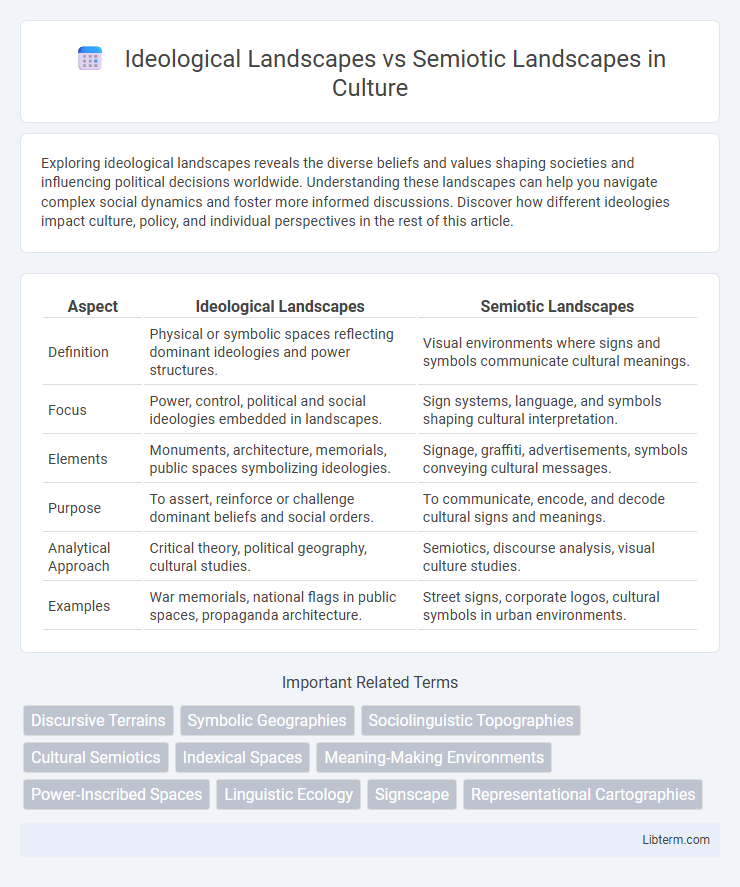Exploring ideological landscapes reveals the diverse beliefs and values shaping societies and influencing political decisions worldwide. Understanding these landscapes can help you navigate complex social dynamics and foster more informed discussions. Discover how different ideologies impact culture, policy, and individual perspectives in the rest of this article.
Table of Comparison
| Aspect | Ideological Landscapes | Semiotic Landscapes |
|---|---|---|
| Definition | Physical or symbolic spaces reflecting dominant ideologies and power structures. | Visual environments where signs and symbols communicate cultural meanings. |
| Focus | Power, control, political and social ideologies embedded in landscapes. | Sign systems, language, and symbols shaping cultural interpretation. |
| Elements | Monuments, architecture, memorials, public spaces symbolizing ideologies. | Signage, graffiti, advertisements, symbols conveying cultural messages. |
| Purpose | To assert, reinforce or challenge dominant beliefs and social orders. | To communicate, encode, and decode cultural signs and meanings. |
| Analytical Approach | Critical theory, political geography, cultural studies. | Semiotics, discourse analysis, visual culture studies. |
| Examples | War memorials, national flags in public spaces, propaganda architecture. | Street signs, corporate logos, cultural symbols in urban environments. |
Defining Ideological and Semiotic Landscapes
Ideological landscapes represent the spatial expressions of economic, political, and cultural ideologies embedded in physical and social environments, reflecting power dynamics and belief systems within a community. Semiotic landscapes encompass the visible signs, symbols, and language scripts in public spaces that communicate social meanings and cultural identities. Both concepts analyze how environments encode and convey messages, but ideological landscapes emphasize underlying power structures, while semiotic landscapes focus on the interpretation of symbols and signs.
Theoretical Foundations of Ideological Landscapes
Theoretical foundations of ideological landscapes are rooted in discourse analysis and critical theory, emphasizing how power relations and social ideologies shape physical and symbolic spaces. Unlike semiotic landscapes that primarily focus on signs and symbols conveying meaning in urban environments, ideological landscapes analyze how these signs perpetuate dominance, identity, and hegemony within society. Key contributors like Henri Lefebvre and Michel Foucault highlight the role of ideology in spatial practices and the production of space, revealing how landscapes function as sites of ideological contestation and control.
Understanding Semiotic Landscapes in Context
Semiotic landscapes involve the analysis of signs and symbols in public spaces, revealing cultural meanings and social values embedded within environments. Understanding semiotic landscapes requires examining how visual elements like advertisements, graffiti, and architecture communicate identity, power relations, and historical narratives in specific contexts. This approach contrasts with ideological landscapes, which emphasize dominant belief systems and political agendas shaping spatial organization.
Key Differences Between Ideological and Semiotic Landscapes
Ideological landscapes comprise physical and symbolic spaces shaped by dominant power structures, reflecting social and political ideologies through monuments, signage, and institutional buildings. Semiotic landscapes emphasize the interpretation of signs and symbols embedded in public spaces, analyzing how meaning is constructed and communicated through visual elements like advertisements, graffiti, and linguistic displays. The key difference lies in ideological landscapes representing explicit power relations and hegemonic messages, whereas semiotic landscapes focus on the broader semiotic processes and cultural codes influencing spatial meaning.
The Role of Language and Symbols in Semiotic Landscapes
Semiotic landscapes integrate language and symbols as powerful conveyors of cultural meaning, shaping public spaces through signs, advertisements, and graffiti that communicate social identities and power dynamics. Language functions as a mutable code, while symbols provide visual metaphors that encode ideological messages within urban environments. This linguistic-symbolic interplay constructs multi-layered semiotic networks, influencing perception and reinforcing collective memory in the spatial context.
Power Dynamics in Ideological Landscapes
Ideological landscapes represent the spatial manifestation of power structures through symbols, texts, and cultural artifacts that enforce dominant worldviews and social hierarchies. These landscapes are embedded with meaning that perpetuates control and resistance by shaping public consciousness and legitimizing authority. In contrast, semiotic landscapes emphasize the broader system of signs and meanings in urban spaces, with less direct focus on dominance and more on communicative diversity.
Intersectionality of Ideology and Semiotics
Ideological landscapes shape collective beliefs and power structures embedded in cultural symbols, while semiotic landscapes represent the spatial distribution of signs and meanings in public spaces. The intersectionality of ideology and semiotics reveals how power relations manifest through symbolic practices, influencing identity, social hierarchies, and spatial narratives. This convergence highlights the role of language, imagery, and symbols in constructing and negotiating sociopolitical realities across diverse communities.
Case Studies: Real-World Examples of Both Landscapes
Case studies of ideological landscapes often highlight urban murals and public monuments that convey dominant political or cultural values, such as the Berlin Wall's graffiti symbolizing Cold War tensions. Semiotic landscapes are exemplified by commercial districts like Times Square in New York, where digital billboards and signage create a dense network of visual symbols conveying consumer culture messages. Both landscapes illustrate how spatial environments communicate power structures and societal norms through visual and symbolic means.
Implications for Urban Design and Public Spaces
Ideological landscapes shape urban design by embedding dominant cultural values and power structures into public spaces, influencing accessibility and social interaction patterns. Semiotic landscapes use signs, symbols, and meanings to communicate identity, heritage, and community narratives, fostering a sense of place and belonging. Integrating both concepts enables urban planners to create spaces that are not only functional but also culturally resonant and inclusive.
Future Research Directions in Landscape Studies
Future research in landscape studies should explore the dynamic interaction between ideological landscapes and semiotic landscapes to better understand how social power and cultural meanings shape spatial environments. Investigating the role of digital technologies and virtual spaces in transforming semiotic landscapes can provide insights into evolving communicative practices and identity formation. Integrating interdisciplinary methods from critical theory, cultural geography, and media studies will enhance analysis of how landscapes encode and contest ideological narratives over time.
Ideological Landscapes Infographic

 libterm.com
libterm.com